An unpopular opinion, but selling is truly an art form that requires a pretty diverse set of skills. There are so many different styles you can learn and approaches you should master.
One of the most impactful being consultative selling.
What Is Consultative Selling?
Not the most well known technique, this approach centers on earning trust and delivering value while exploring needs and offering solutions. Focused more on fostering openness and initiating dialogues with buyers, the goal is to understand the buyer’s unique pain points in more detail.
Long story short, it’s almost the complete opposite of product-focused selling, which can be hard to understand if certain habits have already been learned.
Product-Focused Selling vs. Consultative Selling
You wouldn’t be wrong to reference consultative selling as prospect-focused selling since you’re dominantly working in the prospect’s best interest. On the other end of the spectrum, product-focused selling is run by the need to only showcase your products or services.
For example, instead of asking prospects questions (as you would do in consultative selling), you would spend much of your time describing the benefits of your products or services. You would deliver information only on what you can offer, instead of actually making sure your products or services are a good fit for the prospect.
Product-focused selling can be off putting for interested buyers because they often feel like they're just being sold to, not listened to.
Speaking of listening, one of the most essential skills to possess in all kinds of sales is active listening. In order to gain insight on what your prospects need, you have to ask the right questions and actually hear their answers.
6 Principles of the Process
There are several key steps to follow when practicing consultative selling. These six principles provide a pretty good guide to the methodology, but keep in mind your average sales cycle, what you’re selling, and your buyer personas when building out your plan.
1. Research
Every salesperson should always thoroughly research a lead before taking any further steps. Take the time to study all of the lead intelligence that your organization has been able to gather while acquiring your lead.
You should be able to figure out their needs when you analyze their company, the content they’re interested in, their social media presence, and company news.
The more you know about your lead, the better you’ll be able to serve them.
2. Ask Questions
Ask open-ended questions in order to gather even more information. No one can tell you your lead’s pain points better than your lead. Avoid questions where they can reply with a simple yes or no answer.
Encourage them to go in depth in regards to what their company’s goals and needs are. You should be able to discover their challenges, budget, and timeline from only a few conversations.
Here are a few examples of impactful questions:
- "What do you perceive as your greatest strength? Weakness?"
- "How does your company evaluate the potential of new products or services?"
- “What is a reason that would prompt you to change suppliers?”
- "Would you rather save money, cut costs, or increase productivity?"
3. Actively Listen
None of your lead’s answers are worth anything to you if you don’t actually listen to them. There’s a difference between passive listening and active listening.
In the latter, which should be habitually practiced, you should be focused on what the person is saying and be ready to respond appropriately.
Repeat and rephrase what they have said so you can make sure you understand their point of view, while letting them know that you are paying attention to them.
Make sure to take notes while you practice this technique. Everything said in that conversation can potentially help in qualifying and closing the lead.
4. Educate
Within the same conversation, you’re asking questions, actively listening, and responding, but you should also be looking for opportunities to teach the lead. The goal should be to educate them on how to overcome their obstacles and reach their objectives.
Remember the idea behind consultative selling is to help the lead achieve success. This step is not an opportunity to talk about your product or service. Keep all education opportunities focused on improving the lead’s experience.
5. Qualify
Qualifying your lead is an ongoing process that begins the moment you start researching. Learning about their goals, challenges, and timeline will help you figure out if the lead will end in a sale or not.
Don’t dismiss unqualified leads, though. While they may not be a good fit for you, they provide an opportunity for you to help someone and practice your sales skills. But be ready to move on at some point.
Otherwise, if you're trying to close an unqualified lead, it's a waste of their time, your time, and your resources. It’ll hurt more than it will help trying to pursue a sale that, more than likely, won’t happen and can’t benefit either you or them.
Give most of your time to qualified leads and building those relationships.
6. Close
The moment that every sales team member itches for, it should be easy work to close a lead that you’ve thoroughly researched and engaged with, assuming that they’re qualified. It should be a natural transition that doesn’t apply any tension to the relationship you’ve worked so hard to build.
If any friction does appear, you can remind the lead of what challenges and consequences they’ll face if they choose not to work with you. All of the conversations and research you’ve gathered will back up your stance that they’ll greatly benefit from your product or service.
Consultative Selling Techniques
Once you’ve got a firm grip on the concepts backing consultative selling, you can start studying the selling techniques that will make you a pro.
Mastering these skills will help you make longer-lasting relationships with your prospects that lead to much more profitable sales.
Obtaining this level of success requires the following techniques:
Research In Advance.
Studying up on your lead after you’ve already started corresponding with them can leave you in the awkward position of playing catch up when the race has already begun.
You should be able to approach them with a comprehensive understanding of what they need and where they want to go so you can start the sales cycle off strong. Not only will it make the conversations run smoother, but it will also raise your credibility, shorten the sales cycle, and boost your wins.
Don’t wait for them to give you the information that you need. It appears more professional when you search for the information yourself in advance.
Avoid Being a Seller.
Strong-arming a lead into a sale rarely works and can damage your reputation. The purpose of consultative selling is to help alleviate the lead’s pains, not sell your product or service as quickly as possible.
Of course, you should be working toward making the sale and boosting your success, but you should never treat the lead like they’re just another number on a sales report. Remember that the other person has their goals that they are trying to achieve as well. It’s your job to try and selflessly meet the needs of both parties.
Embrace Authenticity.
When you build a natural, organic relationship with a lead, they feel much more comfortable in being open and honest with their needs and expectations.
With that openness comes a much faster sales process where you can quickly identify their challenges and provide solutions for them.
Start the Conversation With a Plan.
Your job is to provide resolutions to whatever problems the lead is facing. They expect this, so it only makes sense to present them with at least an idea on how you can provide aid to them at the beginning. This is where performing research in advance helps.
Starting with a plan also helps in the qualifying process too. If you learn during the conversation that the path you had prepared for is different from the buyer’s goals, you can adjust accordingly.
Follow Up With Informed Questions.
There’s a difference between being asked questions and being interrogated. Make sure that when you’re asking the lead for more information, you’re asking relevant questions that will contribute towards you finding a solution for them.
In an active conversation where both parties are participating and engaged, it will feel much more natural for you to ask follow up questions that will, ultimately, be beneficial for them.
Focus on Facts. Don’t Assume.
It’s easy, especially in sales, to base your strategies off of your assumptions rather than diving into the lead’s brain. But there’s no avoiding the fact that you need to hear your lead out in order to provide them with the product or service they need.
Pay attention to the details they share with you. Their obstacles, budget, and goals aren’t opinions; they’re facts.
To conduct proper business, you should be acting off of those facts. You won’t achieve much success if you work outside the reality of the matter and operate in any way you see fit.
Skills You Need for Consultative Selling
There are so many sales skills that actually translate over to consultative selling. Some of the most important ones include:
Confidence
Every successful performer will tell you that confidence is one of the most important keys to success. When you can appear confident in the face of rejection, you have a greater chance of changing that “no” into a chance to learn and grow.
Your leads will notice it too. As human beings, we have an easier time placing our trust in someone who appears confident, credible, and knowledgeable.
Even if you have to fake it until you make it, they’re not going to know the difference. They’ll just see someone who is an expert in the field and have the thought, “I want to work with them!”
Honesty
In every aspect of life, it’s difficult to admit when you’re wrong. But, believe it or not, practicing integrity actually bolsters your credibility from a customer’s perspective.
Taking responsibility for mistakes and being able to admit that you simply don’t know the answer sometimes paints you as a mature, relatable person.
It’s easy to not lie, but that isn’t all there is to honesty. The hardest part is owning up to your mistakes, admitting you're wrong, and being able to take responsibility for the consequences that follow.
Empathy
Relating to a customer’s emotional experience makes them feel validated and helps you identify what they’re looking for in a sale. Empathy is incredibly underrated in sales and that needs to change.
All throughout the consultative selling process, building a healthy relationship with your lead is encouraged. Empathy is both a contributor and a product of that relationship.
Paying attention to their questions, answers, and concerns will help build trust between the two of you, which leads to a much more positive and productive sales experience.
Interviewing Skills
Even though your conversations with a lead should never feel like an interrogation, you should still have the skills necessary to guide the conversation.
Honing your interviewing skills will help you gently lead the conversation where you need it to go for you to get the useful information that you need.
Consultative Selling Resources: Books and Digital Courses
To further your knowledge on the methodology, there are plenty of incredible online resources and books at your disposal. Use all the tools you can to brush up on the consultative selling process.
Consultative Selling Books
Consultative Selling: The Hanan Formula for High-margin Sales at High Levels
Author: Mack Hanan
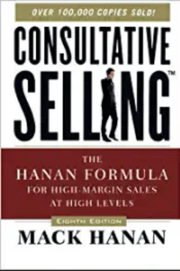
Source: Amazon
Mack Hanan breaks down the formula of consultative selling for salespeople to build long-lasting relationships with customers.
Diving deep into the methodology, Hanan goes over sales models, building consultative databases, how to effectively study your customers, and how to use consultative selling strategies on the web.
SNAP Selling: Speed Up Sales and Win More Business with Today's Frazzled Customers
Author: Jill Konrath
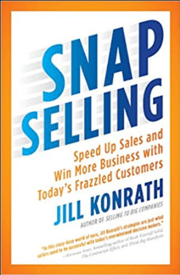
Source: Amazon
This book covers how to tackle customer hesitation in today’s day and age. Konrath uses her years of sales experience to teach how to book more appointments, speed up the decision stage, and win sales.
She offers four SNAP rules:
- Keep It Simple: Make things easy and clear for your customers.
- Be iNvaluable: Stand out by being the person your customers can't live without.
- Always Align: Make sure you're in synch with your customers' objectives, issues, and needs.
- Raise Priorities: Keep the most important decisions at the forefront of their mind.
Integrity Selling for the 21st Century: How to Sell the Way People Want to Buy
Author: Ron Willingham
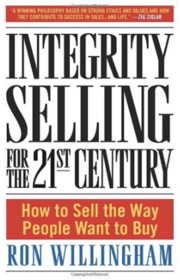
Source: Goodreads
Drafted as a blueprint to achieving your goals while staying true to yourself and your values, Willingham explores what it means to self-evaluate in the sales process and how it can help you become a better salesperson.
Through establishing your own goals and integral value, you can evaluate them in the business climate and learn how to adapt your selling styles for more productive client relationships.
Authenticity: The Head, Heart, and Soul of Selling
Author: Ron WIllingham
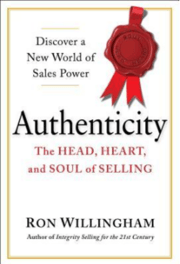
Source: Goodreads
In this book, WIllingham shares how emotions are huge contributors to sales success. He shares what he’s learned about the true causes of sales success and failure and how to navigate through them.
The book also dives deep into a step-by-step guide on bringing the most value you can to customers and how to use enhanced social skills to further develop strong relationships.
Selling with Integrity: Reinventing Sales Through Collaboration, Respect, and Serving
Author: Sharon Drew Morgen
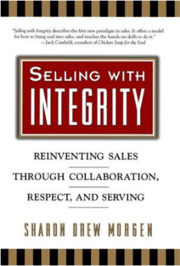
Source: Goodreads
Based on Sharon Drew Morgen’s belief that closing a sale comes second to respecting the buyer’s needs, this book debates the idea that a salesperson’s main priority should be the buyer.
Morgen argues that traditional selling methods lack the integrity, honesty, and humanity necessary to create win-win situations in business. She provides case studies, schematics, and insight into the skill sets necessary to drive sales success.
Consultative Selling Courses
Baker Communications’ Consultative Selling Skills
Providing four different delivery methods, Baker Communications’ course teaches how to stop “pushing” products and start “pulling” customers.
Built around 90-minute virtual modules and collaboration tools, participants will learn how to build trust with different types of customers, grasp the difference in buying factors, perform in-depth needs analysis, anticipate and handle customer hesitation, and other critical techniques necessary for success,
Growth Development Associate’s Free Introduction to Consultative Selling
A one hour e-learning course composed of two modules, GDA offers an introductory overview of consultative selling for free.
They teach several best practices and selling techniques to refine your skill set. They have an additional eight course teaching experience to provide more in-depth knowledge of the practice for $599.
Richardson Consultative Training Program
Promoting six critical skills, Richardson’s Consultative Training primarily focuses on the structure of a sales conversation.
Built to teach more buyer-focused dialogue skills, participants are expected to assess their current methods and adapt them as necessary. Offering three different delivery options, the program is highly customizable.
Zoe Talent Solutions’ Consultative Selling Course
This consultative selling course goes over how to develop your selling skills and “activate” your relationships with leads.
You’ll learn new listening skills, what questions to ask, and how to organically introduce solutions into the sales cycle. Depending on your team’s needs, customized proposals can be arranged for the course.
Build a Human, Personal Experience
The world of sales is evolving and customers are wanting newer, more personal approaches to the process.
Once you’ve learned the basics of consultative selling, you’re ready to drive results for your organization and bring true value to your leads and prospects.

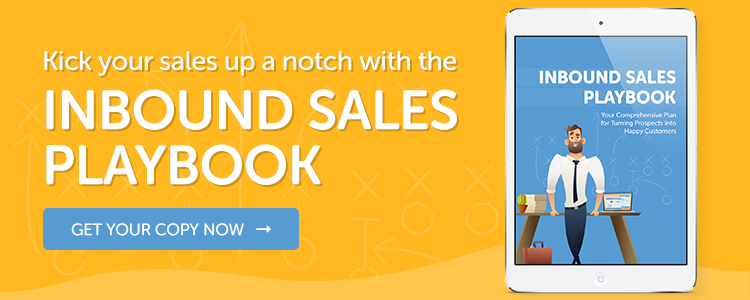
Micah Lally
I’m a Content Writer at Bluleadz. I’m a big fan of books, movies, music, video games, and the ocean. It sounds impossible to do all of those at the same time, but you’d be surprised by the things I can accomplish.